
Station Name: HOLME (Lancs)[Source: Alan Young]
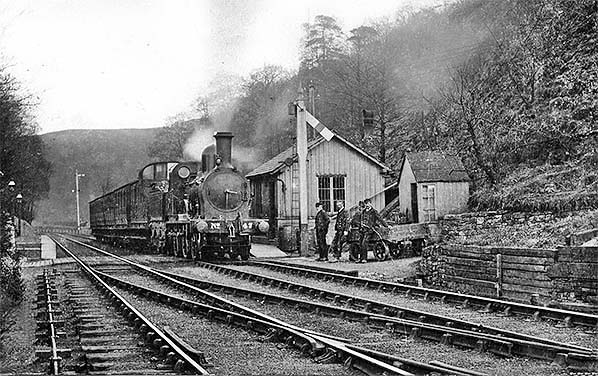 Holme (Lancs) station looking south-east c1905. The passenger train is standing at the down (Burnley-bound) platform, headed by a 2-4-0 tender locomotive, apparently No.47 but otherwise unidentified. The modest station building of timber on a stone base can be seen beyond the trolley and the railwaymen. Unfortunately, although the up platform is shown the buildings are out of sight.
Copyright photo from John Alsop collection  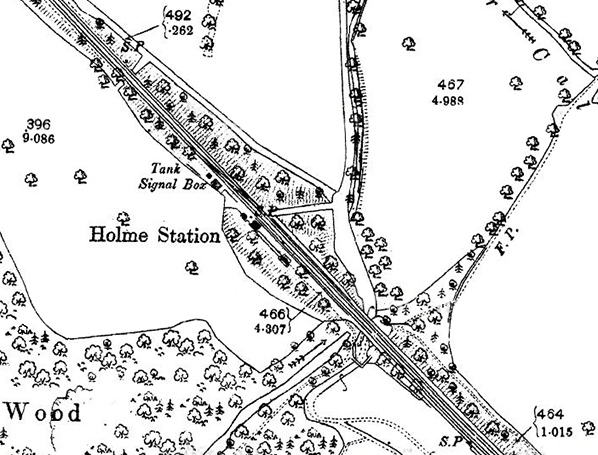
1892 1: 2,500 OS map. The station serves Holme Chapel (as the settlement is called in 2016) one of several rural industrial communities in the parish of Cliviger. The lane from Holme Chapel enters this map extract from the north, with a branch path leading directly to the station. There are two facing platforms with the main station building being shown at the north-west end of the down platform, opposite the approach path, and a further building midway along the platform. The signal box and water tank are also on the down side, north-west of the station. No buildings are shown on the up platform. Goods facilities are not provided. The footpath direct from Holme Hall for the Whitaker family is identified as ‘F.P.’. It can be seen to pass below the railway, then a footbridge carries it over the extension of the station access lane and the double pecked lines indicate the approach of the footpath to the down platform.
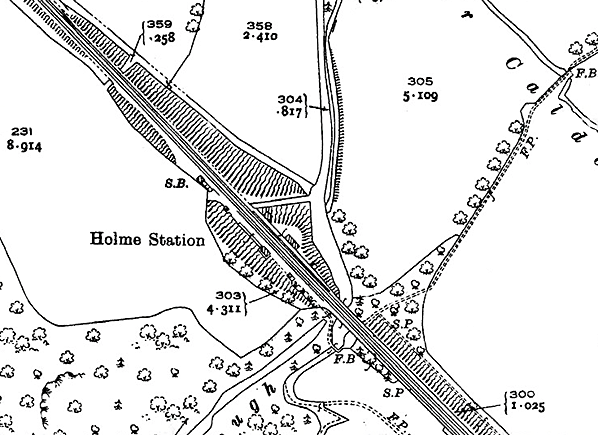 1930 1: 2,500 OS map. This is the year in which Holme station closed. Some stations proved to be magnets for industry and housing, but this has clearly not happened at Holme; the station remains isolated and inconveniently placed to serve the community at Holme Chapel which is on the main Burnley-Todmorden road. Following the demolition of the main station building as a result of a train derailment in 1907 a new building has been constructed some distance south-east of its predecessor. A building is now shown midway along the up platform. The signal box is still marked and named even though it has long been disused.
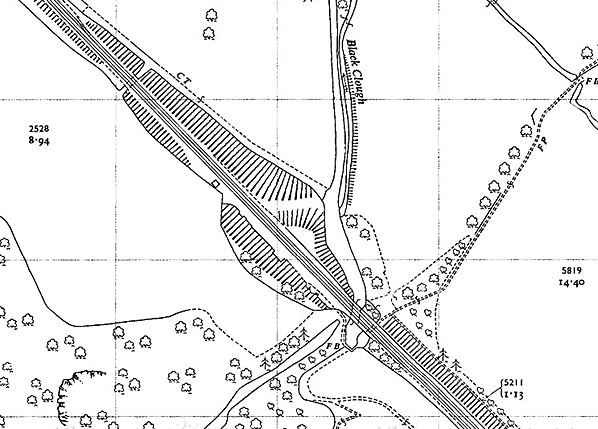
1960 1: 2,500 map. Holme station closed in 1930. Thirty years later the irregular shape of the embankment is the clearest evidence that a station was on this site. The access path to the station is no longer shown, but it is implied by the configuration of the earthworks. The signal box is shown but no longer named.
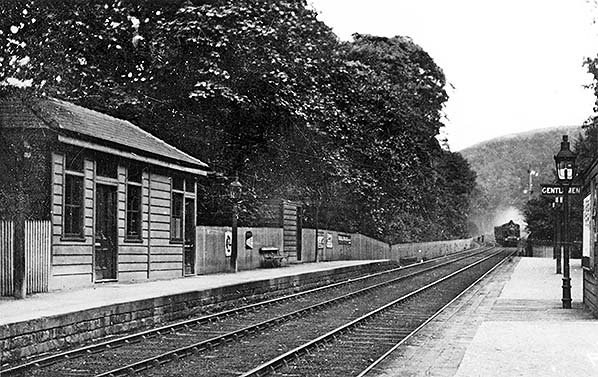
Holme (Lancs) station looking south-east c1905. A passenger train is approaching having passed through Holme Tunnel, which can be seen in the background. A waiting room and ladies’ toilet are in the hipped-roofed timber building on the up platform, far left, and the small timber building beyond is a gents’ toilet. On the down platform the gents’ facilities are clearly signed. The lamp standards with elegant lanterns for the oil lamps will be noted.
Photo from John Mann collection 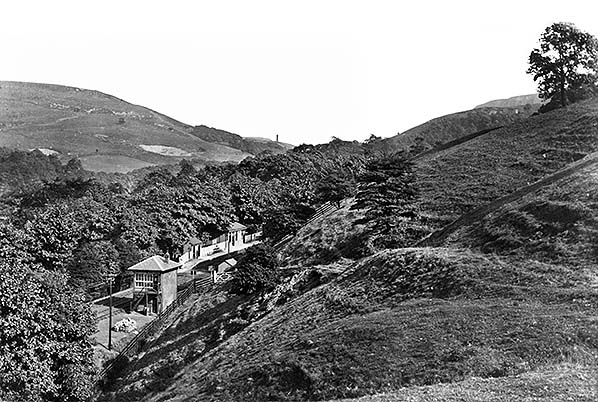
Holme (Lancs) station looking east from an elevated position. The date is estimated as c1905; this was the year when the station’s signal box, featuring prominently in this view, was closed. The station building at the end of the down (Burnley-bound) platform is seen to the right of the signal box, and two buildings are visible on the up platform. The steep slopes of the Cliviger Gorge and the isolated position of the station can be appreciated in this view.
Copyright photo from John Alsop collection 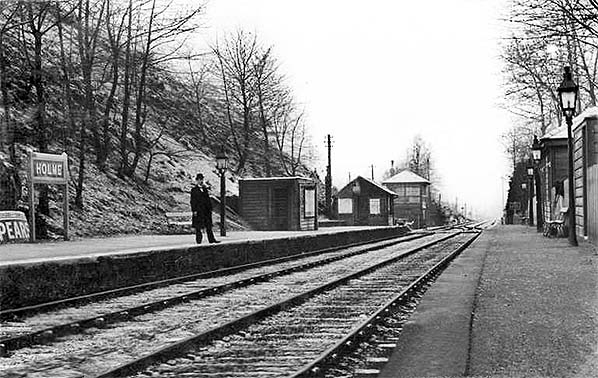 Holme (Lancs) station looking north-west from the up (Todmorden-bound) platform c1905. On the down platform the LYR running-in nameboard is prominent, followed by the gents’ toilet and the modest station building which was demolished in the train crash of 1907. The signal box, closed in 1905, is seen beyond the platform. On the up platform the timber buildings just sneak into the view, but the series of stately oil lanterns is clearly seen.
Photo from John Mann collection 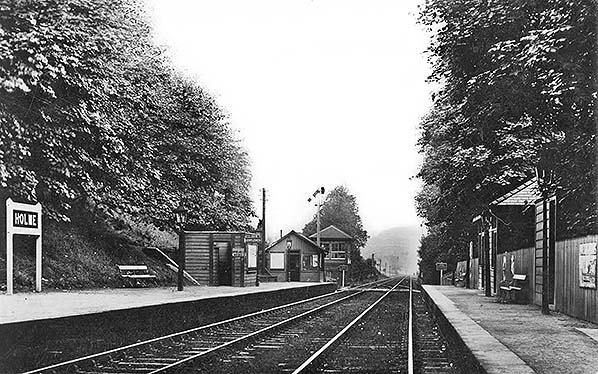
Holme (Lancs) station looking north-west from the up track c1905. On the down platform (left) the LYR running-in nameboard is prominent, followed by the gents’ toilet and the modest station building. This building was destroyed in the train crash of 1907. The signal box, closed in 1905, is seen beyond the platform. On the up platform the nearest building is the gents’ toilet, followed by a larger structure containing a waiting room and ladies’ toilet.
Copyright photo from John Alsop collection
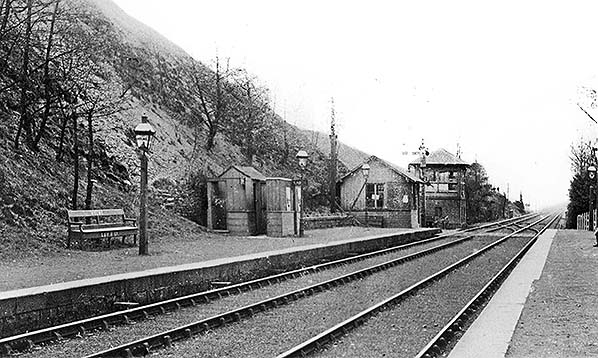
Holme (Lancs) station is seen in the early twentieth century, looking north-west from the up platform prior to the accident of 1907, when a derailed goods train demolished the buildings on the opposite platform and fatally injured the deputy stationmaster. This viewpoint provides an opportunity to study the design of the structure containing the gents’ toilet (centre of the picture), and the very modest main building of the station is seen beyond. The Saxby & Farmer Type 9 signal box, constructed in 1877/78 is seen in the background behind the signal. This box would close in 1905. The bench, far left, carries the station and the company’s names; the nearest oil lantern also proclaims the name of the station.
Photo from John Mann collection 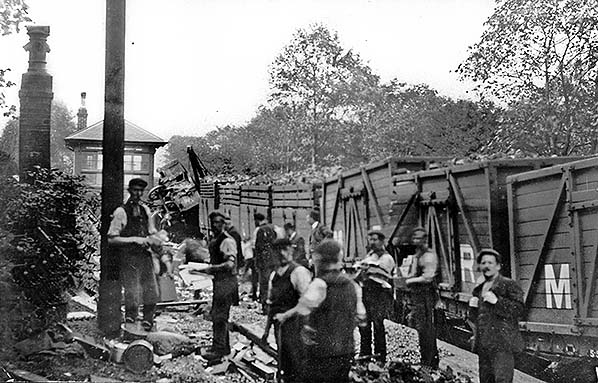 Holme (Lancs) station is seen on 27 September 1907 shortly after a Normanton to Liverpool goods train has been spectacularly derailed and the wagons have demolished the main building on the down platform, on which this photograph was taken. The deputy stationmaster, William Pim, was fatally injured. The chimneystack is standing but the rest of the building has been reduced to rubble. The signal box, disused since 1905, has escaped destruction. A gang of about 50 workmen arrived from Accrington with the task of clearing the damage and returning the line to use, assisted by locomotives and heavy machinery; some of the men appear to be taking a break. A similar group today would be kitted out in hard hats and hi-vis jackets. A railway crane can be seen attending to the Holme (Lancs) station is seen on 27 September 1907 shortly after a Normanton to Liverpool goods train has been spectacularly derailed and the wagons have demolished the main building on the down platform, on which this photograph was taken. The deputy stationmaster, William Pim, was fatally injured. The chimneystack is standing but the rest of the building has been reduced to rubble. The signal box, disused since 1905, has escaped destruction. A gang of about 50 workmen arrived from Accrington with the task of clearing the damage and returning the line to use, assisted by locomotives and heavy machinery; some of the men appear to be taking a break. A similar group today would be kitted out in hard hats and hi-vis jackets. A railway crane can be seen attending to thedistant upturned wagon. Copyright photo from John Alsop collection 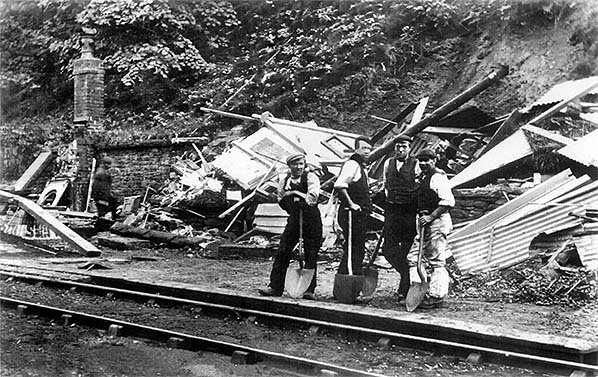 On 27 September 1907 a goods train bound for Liverpool broke into two sections approaching Holme, and the sections collided at the station, demolishing the main building on the down platform and killing the deputy stationmaster, William Pim. The remains of the building can be seen on the left, including the chimneystack, while a group of men involved in clearing the debris and returning the line to use are taking a break from their labours.
Photo from John Mann collection 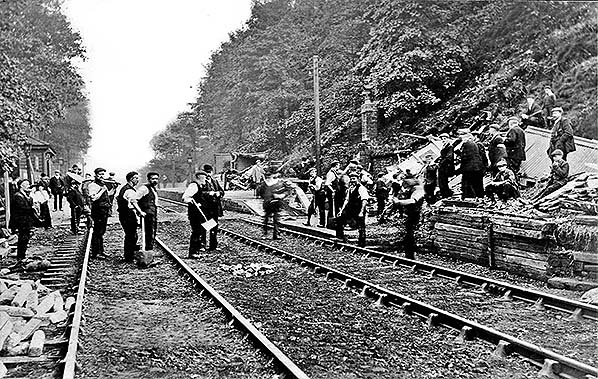
This view of Holme (Lancs) station, looking south-east, shows the extent of the damage caused by a derailed goods train on 27 September 1907. The Normanton-Liverpool train had broken into two sections on the approach to Holme; the sections collided at the station, the wagons mounting the down platform and demolishing the station building. Only the chimneystack has survived, the rest of the building being reduced to rubble. The timber building further along the platform has also been damaged. The deputy stationmaster, William Pim, was killed in the accident. A large gang of workmen is engaged in clearing the debris after the derailed wagons (seen on the previous photograph) have been removed.
Copyright photo from John Alsop collection
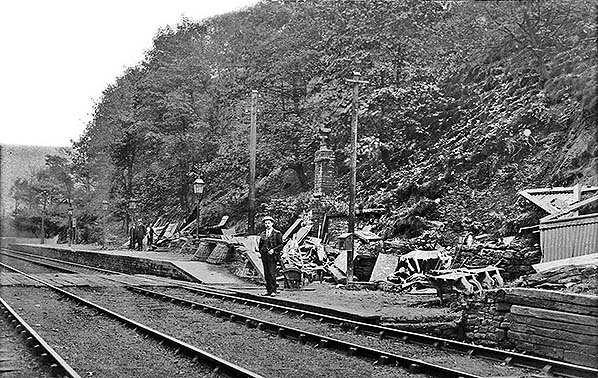 Holme (Lancs) station is seen here, looking south-east, probably a few days after the accident of 27 September 1907 in which a derailed goods train killed the deputy stationmaster and demolished the main building on the down platform. The chimneystack is all that remains of the station building, and the debris of this structure is still strewn along the slope behind the platform. Halfway along the platform, where the three men are gathered, the gents’ toilet block was badly damaged in the accident and has since been demolished; the timber from this building is seen behind the platform at this point. The lamps and nameboard at the far end of the platform appear to have survived the accident unscathed, but new lamp standards have been erected at the near end of the platform. The smartly dressed gentleman is standing beside the platform levers which were installed, presumably in 1905, when the station’s signal box closed and the location ceased to be a block post. One of the levers might have been used to release the wicket gate at the north-east side of the barrow crossing. Holme (Lancs) station is seen here, looking south-east, probably a few days after the accident of 27 September 1907 in which a derailed goods train killed the deputy stationmaster and demolished the main building on the down platform. The chimneystack is all that remains of the station building, and the debris of this structure is still strewn along the slope behind the platform. Halfway along the platform, where the three men are gathered, the gents’ toilet block was badly damaged in the accident and has since been demolished; the timber from this building is seen behind the platform at this point. The lamps and nameboard at the far end of the platform appear to have survived the accident unscathed, but new lamp standards have been erected at the near end of the platform. The smartly dressed gentleman is standing beside the platform levers which were installed, presumably in 1905, when the station’s signal box closed and the location ceased to be a block post. One of the levers might have been used to release the wicket gate at the north-east side of the barrow crossing.Copyright photo from John Alsop collection Click here for Holme Station Gallery 2: circa 1910 - October 2016
|
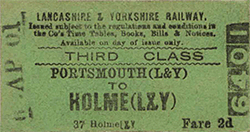 The station also served Holme Hall (also known as ‘The Holme’ or, simply, ‘Holme’) residence of the Whitaker family. The hall is about half a mile north-east of the station, on the far side of Burnley Road, now the A646 between Todmorden and Burnley; at the time of writing (November 2016) it is undergoing conversion into ‘luxury’ apartments. It seems that the Whitakers preferred not to mingle with the local people when travelling between their home and the station, so they enjoyed the privacy of their own footpath. This passed under Burnley Road then crossed the family’s fields, with a footbridge over the River Calder; having passed beneath the railway, approaching the station there was a private stone arched footbridge beyond which the path continued directly to the down platform. This bridge survives, and without an understanding of its obscure origin and purpose it would appear to be little more than a folly, standing as it does just a few yards from the similar bridge which carries the railway over the track beyond the station. There is a local belief that the Whitakers chartered a complete railway carriage which stopped at a section of segregated platform which was reached by the bridge, but no reliable evidence has been found of this. I am grateful to Ken Geddes for providing information on the association of the station with the Whitakers of Holme Hall.
The station also served Holme Hall (also known as ‘The Holme’ or, simply, ‘Holme’) residence of the Whitaker family. The hall is about half a mile north-east of the station, on the far side of Burnley Road, now the A646 between Todmorden and Burnley; at the time of writing (November 2016) it is undergoing conversion into ‘luxury’ apartments. It seems that the Whitakers preferred not to mingle with the local people when travelling between their home and the station, so they enjoyed the privacy of their own footpath. This passed under Burnley Road then crossed the family’s fields, with a footbridge over the River Calder; having passed beneath the railway, approaching the station there was a private stone arched footbridge beyond which the path continued directly to the down platform. This bridge survives, and without an understanding of its obscure origin and purpose it would appear to be little more than a folly, standing as it does just a few yards from the similar bridge which carries the railway over the track beyond the station. There is a local belief that the Whitakers chartered a complete railway carriage which stopped at a section of segregated platform which was reached by the bridge, but no reliable evidence has been found of this. I am grateful to Ken Geddes for providing information on the association of the station with the Whitakers of Holme Hall. 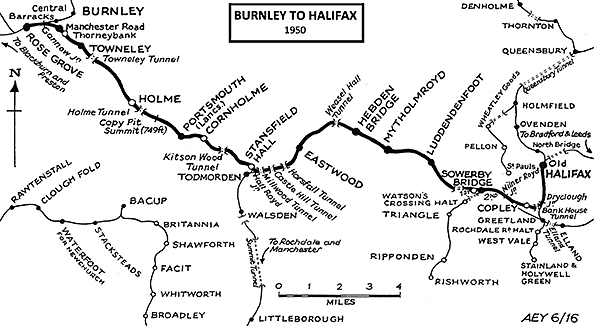

 Home Page
Home Page